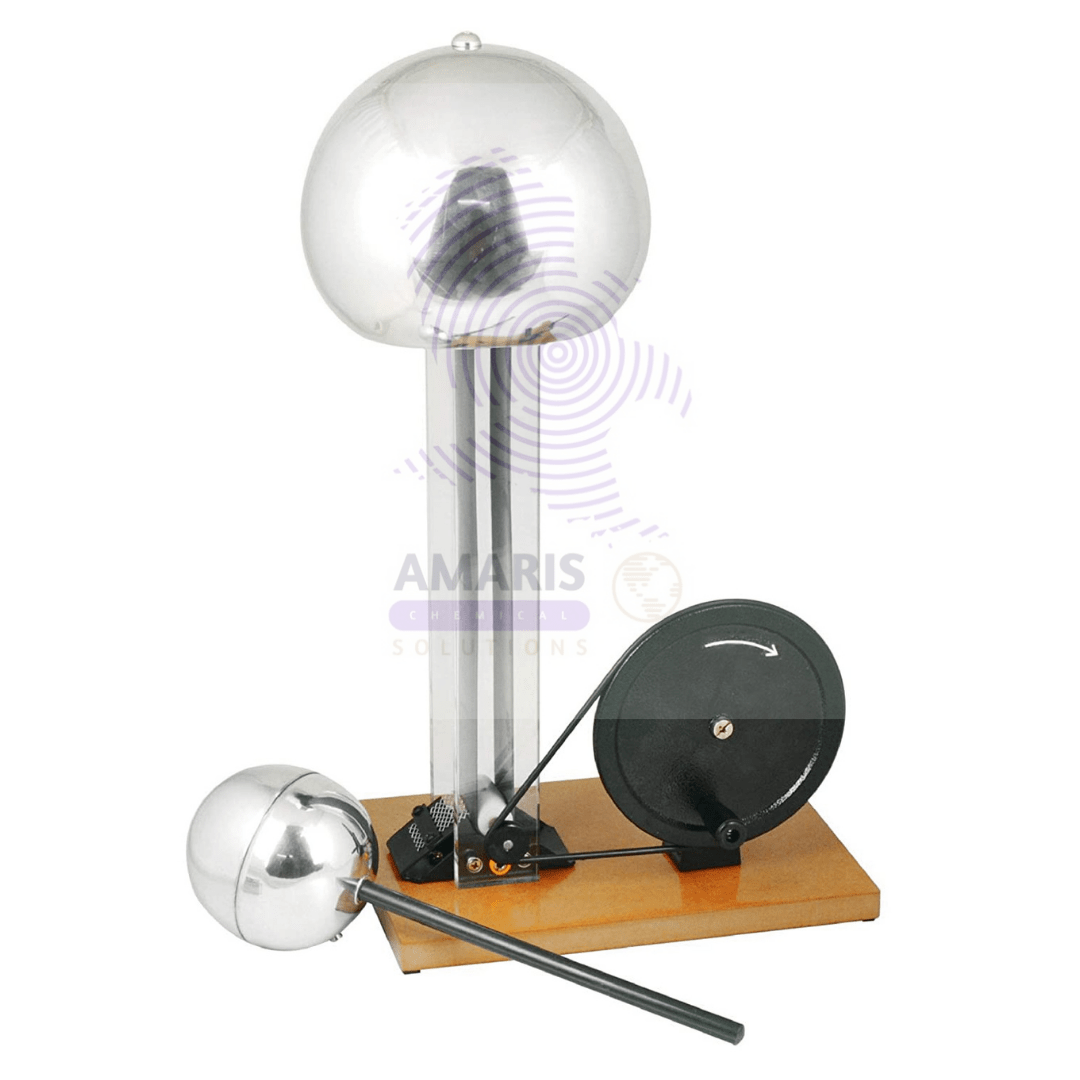“Balance Electronic Ohaus cl 200” has been added to your cart. View cart

Burette acrylic
$0.01

Ticker tape timer
$6,000.00 Original price was: $6,000.00.$5,500.00Current price is: $5,500.00.
Van de generator manual
$7,000.00 Original price was: $7,000.00.$6,000.00Current price is: $6,000.00.
Whatsapp Order
Van de Graaff generators are commonly used in laboratory settings to demonstrate principles of electrostatics and high voltage phenomena. While specific manuals can vary based on the manufacturer and model of the generator
SKU:
ACS37973CHEM0
Category: LABORATORY EQUIPMENT & APPARATUS
Description
Van de generator manual
- Setup:
- Place the Van de Graaff generator on a stable, level surface, preferably grounded to prevent electrical interference.
- Ensure the generator is connected to a suitable power source, adhering to the specified voltage and current requirements.
- Confirm that all necessary safety precautions are in place, including the use of personal protective equipment (PPE) such as safety goggles and gloves.
- Assembly:
- Erect the generator components as per the provided instructions, including the base, insulating column, belt assembly, and terminal sphere.
- Securely attach any supplementary apparatus, like discharge wands or Faraday cages, following the manufacturer’s guidelines.
- Charging:
- Activate the Van de Graaff generator by toggling the power switch to the “On” position.
- Gradually adjust the voltage settings, starting from the lowest setting and incrementally increasing to the desired level.
- Allow sufficient time for the generator to build up charge accumulation on the terminal sphere or dome.
- Experimental Procedures:
- Conduct a range of experiments to elucidate electrostatic principles and phenomena.
- Examples include:
- Observing the repulsion or attraction of lightweight objects (e.g., balloons, pith balls) by the charged terminal.
- Investigating the impact of electrostatic forces on the behavior of insulating and conducting materials.
- Demonstrating the effects of induced charges and electric fields through visual aids and measurements.
- Exploring phenomena such as corona discharge, electric breakdown, and ionization.
- Safety Guidelines:
- Adhere strictly to safety protocols outlined in the manual and any institutional regulations.
- Minimize physical contact with generator components while in operation, especially when operating at high voltages.
- Avoid operating the Van de Graaff generator in environments with high humidity or moisture content.
- Implement adequate grounding and insulation measures to mitigate the risk of electrical shocks or discharge accidents.
- Shutdown:
- Upon completion of experiments, deactivate the Van de Graaff generator by switching off the power supply.
- Allow the generator to discharge completely before disassembling or moving any components.
- Store the generator in a designated area, protecting it from environmental hazards and ensuring accessibility for future use.
Reviews (0)
Be the first to review “Van de generator manual” Cancel reply
Related products
Atomic Model Set
$0.01
A lab atomic model set is a collection of physical models and materials designed to represent the structure of atoms and molecules. It is commonly used in educational and scientific laboratory settings to visually demonstrate the arrangement of protons, neutrons, and electrons within an atom, as well as the bonding patterns between atoms in molecules. These sets typically include colored balls of various sizes representing different types of atoms, as well as connectors or magnets to simulate chemical bonds between them. The purpose of these sets is to help students and researchers better understand the principles of atomic and molecular structure in a tangible and interactive way.
Balance Bathroom Scale
$0.01
bar and gauge apparatus
$0.01
Barlows wheel apparatus
$0.01
The Barlow's wheel apparatus is an experimental device used to demonstrate the conversion of electrical energy into mechanical energy through electromagnetic principles. It consists of a horizontal wheel or disk with radial metal spokes attached to its center. The wheel is mounted on an axle, allowing it to rotate freely.
Beaker Simax
$0.01
A glass beaker is a cylindrical, open-top container made of glass, typically with graduated volume markings on its side. It is commonly used in laboratories for holding, mixing, and heating liquids, as well as for performing various experiments and chemical reactions. Glass beakers come in various sizes and are designed to provide easy observation of the contents and to withstand temperature changes without significant deformation or chemical interaction with the substances being used.
bell in vacuum
$0.01
A "bell in vacuum" apparatus is a scientific setup used to demonstrate the effects of reduced air pressure (vacuum) on sound transmission. It typically consists of a bell or sound-producing object enclosed within a sealed chamber from which air has been removed, creating a low-pressure environment. This apparatus is designed to illustrate how sound travels differently in a vacuum compared to in normal atmospheric conditions, highlighting the role of air molecules in sound propagation.
blow pipes
$0.01
A blowpipe apparatus is a scientific instrument used in analytical chemistry and mineralogy for conducting various tests, particularly flame tests and microchemical reactions. It typically consists of a small tube or pipette through which a controlled stream of air or oxygen is blown onto a sample being heated. This stream of air or oxygen enhances the combustion of the sample, allowing the observation of characteristic colors emitted by different elements when they are vaporized and excited by the heat. The blowpipe apparatus is often used to identify and differentiate between different elements and compounds based on their unique emission spectra and reactions.



 LABORATORY EQUIPMENT & APPARATUS
LABORATORY EQUIPMENT & APPARATUS
 Fertilizers
Fertilizers Plant Growth Regulators
Plant Growth Regulators Soil Conditioners
Soil Conditioners Animal Feed Additives
Animal Feed Additives Biostimulants
Biostimulants Dough Conditioners
Dough Conditioners Flour Treatments
Flour Treatments Fat Replacers
Fat Replacers Preservatives (baking)
Preservatives (baking)
 Surfactants (cleaning)
Surfactants (cleaning) Builders
Builders Bleaching Agents
Bleaching Agents Enzymes
Enzymes Solvents (cleaning)
Solvents (cleaning) Fragrances
Fragrances






















Reviews
There are no reviews yet.